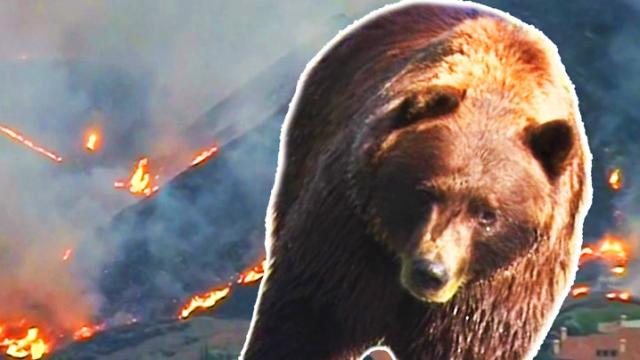Associated Press
Ida collapses Mississippi road; kills 2, injures at least 10

LUCEDALE, Miss. (AP) — Barbara Cochran said she was about to get ready for bed late Monday when she heard a loud crash outside her home in rural southeastern Mississippi. Hurricane Ida had been dumping torrential rain, her husband was already asleep and the home’s air conditioner was humming loudly.
The 83-year-old retired educator said she went onto the porch to see if a big oak tree had fallen, or if an 18-wheeler had slid off the highway down the hill from their home. She didn’t see car lights, so she didn’t think there was a wreck.
About 10 minutes after she went back inside, she heard a second loud crash. Moments later, Cochran heard a third crash. As she was about to call the sheriff’s department, she heard the wail of sirens.
And, she said: “I heard something that sounded like a woman screaming.”
Two people were killed and at least 10 others were injured late Monday when seven vehicles plunged, one after another, into a deep hole where a dark, rural highway collapsed as Hurricane Ida blew through Mississippi, authorities said Tuesday.
Heavy rainfall may have caused the collapse of two-lane Mississippi Highway 26 west of Lucedale, and the drivers may not have seen that the roadway in front of them had disappeared, Mississippi Highway Patrol Cpl. Cal Robertson said. The George County Sheriff’s Department received the first call at about 10:30 p.m.
Cochran told The Associated Press that she didn’t know about the highway collapse or the wrecks until after she woke from a fitful night’s sleep. She said she is praying for the families of those killed or hurt.
“This is such a catastrophe,” Cochran said Tuesday.
Robertson said some of the vehicles ended up stacked on top of each other as they crashed into the abyss, which opened up in a rural area without street lights. Ida dumped as much as 13 inches (33 centimeters) of rain as it blew through Mississippi, the National Weather Service said.
“You can imagine driving at night with heavy rain coming down,” Robertson said. “It’s just nothing but a wall of water, your headlights kind of reflecting back on you.”
State troopers, emergency workers and rescue teams responded to the crash site about 60 miles (96 kilometers) northeast of Biloxi, to find both the east and westbound lanes collapsed. Robertson said the hole removed about 50 to 60 feet (15 to 18 meters) of roadway, and is 20 to 30 feet (6 to 9 meters) deep.
George County Sheriff Keith Havard told the Sun Herald that the sheriff’s department received a 911 call from a man whose car had plunged into the hole.
“He said he was driving and all of a sudden he wasn’t driving anymore,” Havard said. “He didn’t understand what had happened. I can’t imagine anyone would.”
The newspaper reported that 911 dispatchers heard other vehicles crash into the pit.
The vehicles were later lifted out by a crane, leaving some debris at the bottom of the hole. A drone video published by the Sun Herald showed how a raised berm beneath the road washed away, leaving a red-clay scar that runs for hundreds of feet, from a cemetery on one side into a wooded area on the other.
“It is a slide, which means the ground under the roadway and embankment was super-saturated and we can tell right now that’s what caused the slide,” Kelly Castleberry, district engineer for the Mississippi Department of Transportation, told the newspaper.
Jerry Lee, 49, of Lucedale, was pronounced dead at 1:20 a.m., and Kent Brown, 49, of Leakesville, was pronounced dead 10 minutes later, George County Coroner DeeAnn Murrah said.
George County High School said one of its students, a senior, was hospitalized with critical injuries after crashing into the hole. Local schools were closed Tuesday because the collapsed highway created problems for buses and other traffic.
Mississippi southern district Transportation Commissioner Tom King said he didn’t know anything unusual about the soil conditions where the highway caved in.
“We just got bombarded here in south Mississippi with rain,” King told the AP.
King said work crews were checking other highways in areas that received heavy rain from Ida.
Between 3,100 and 5,700 vehicles drive along the stretch of highway on an average day, according to Mississippi Department of Transportation data.
“It’s going to take us a while to redo it and make it right again and make it safe for folks to go over,” King said of the collapsed roadbed.
Mike Dillon is pastor of Crossroads United Pentecostal Church, which is near the crash site. He said he learned about the crashes after he woke up Tuesday and checked a community prayer page online. Like many local residents, he walked to the crash site and prayed.
“We’re a very close-knit community,” Dillon said, “and we’re going to get through this with the help of the Lord.”
Hurricane Ida blasted ashore Sunday as a Category 4 storm, one of the most powerful ever to hit the U.S. mainland. It knocked out power to much of southeastern Louisiana and southern Mississippi, blowing roofs off buildings and causing widespread flooding as it pushed a surge of ocean water that briefly reversed the flow of the Mississippi River.
This story has been corrected to show that Jerry Lee was 49, not 42.
Emily Wagster Pettus reported from Jackson, Mississippi.












